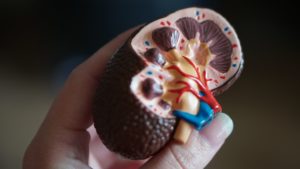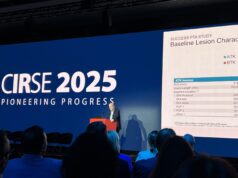 Acute kidney injury is a common complication after intervention for peripheral arterial disease (PAD), and is associated with “medium-term mortality” following percutaneous transluminal angioplasty (PTA), a new study in the British Journal of Surgery (BJS) finds. Authored by Emmanuel Katsogridakis (National Institute for Health Research, Leicester Biomedical Research Centre, University of Leicester, Leicester, UK) and colleagues, the paper concludes that while the present work makes evident the fact that the development of acute kidney injury is independently associated with medium-term mortality at two years, the observational nature of the study means the authors “cannot fully elucidate the pathophysiological mechanisms underlying this association”. They call for future research using relevant subclinical markers and mechanistic assessments to shed light on this.
Acute kidney injury is a common complication after intervention for peripheral arterial disease (PAD), and is associated with “medium-term mortality” following percutaneous transluminal angioplasty (PTA), a new study in the British Journal of Surgery (BJS) finds. Authored by Emmanuel Katsogridakis (National Institute for Health Research, Leicester Biomedical Research Centre, University of Leicester, Leicester, UK) and colleagues, the paper concludes that while the present work makes evident the fact that the development of acute kidney injury is independently associated with medium-term mortality at two years, the observational nature of the study means the authors “cannot fully elucidate the pathophysiological mechanisms underlying this association”. They call for future research using relevant subclinical markers and mechanistic assessments to shed light on this.
Symptomatic PAD is frequently managed with PTA, particularly in patients with significant co-morbidities, including chronic kidney disease (CKD) and cardiovascular disease. These patients are at risk of developing acute kidney injury after PTA. Postprocedural AKI is not innocuous, the authors write, even for patients with a transient decline in renal function, as it is strongly associated with more complications and a higher financial burden for healthcare providers. As the incidence of, and risk factors for, acute kidney injury after endovascular intervention for PAD are unknown, the study investigators sought to assess the proportion of patients who develop acute kidney injury, and to explore the risk factors.
Their primary aim was to assess the incidence of acute kidney injury after PTA. The primary outcome was therefore the proportion of patients who developed acute kidney injury after PTA, using the Kidney Disease Improving Global Outcomes (KDIGO) reporting criteria. Secondary outcomes were the proportion of patients who died, underwent a major amputation, required dialysis within 90 days of intervention, remained dialysis-dependent after 90 days of intervention, or developed the major adverse kidney events (MAKE) endpoints—death, dialysis, and/or drop in estimated glomerular filtration rate of at least 25%—at 30 or 90 days (MAKE30 and MAKE90, respectively).
Katsogridakis et al prospectively collected and analysed data on 2,041 patients undergoing femoropopliteal endovascular intervention for symptomatic PAD (Rutherford stages III–VI) between 2014 and 2019 across three vascular centres.
Acute kidney injury developed in 239 patients (11.7%), with 47 (2.3%) requiring dialysis within 30 days, and 18 (0.9%) requiring ongoing dialysis. The MAKE30 and MAKE90 composite endpoints were reached in 358 (17.5%) and 449 (22%) patients respectively. Risk factors for acute kidney injury were age, sex, congestive heart failure, chronic limb-threatening ischaemia, emergency procedure, and pre-existing chronic kidney disease. Acute kidney injury, dementia, congestive heart failure, and major amputation were risk factors for medium-term mortality, the authors report.
Commenting on these findings, Katsogridakis and colleagues note: “The acute kidney injury-specific risk factors identified in this series are mostly non-modifiable. Older age, male sex, history of congestive heart failure, CLTI [chronic limb-threatening ischaemia], and preoperative renal function have all been associated with acute kidney injury development previously in a variety of clinical settings, and were strongly associated with acute kidney injury in this study. It is not surprising that these parameters are associated with acute kidney injury in patients with severe PAD. Alongside these findings, the absence of correlation between contrast volume and subsequent acute kidney injury in this series further confirms that acute kidney injury encompasses a plethora of other pathophysiological mechanisms, including perioperative volume depletion, nephrotoxicity, and renal microembolisation. Efforts in the prevention of this complex and important complication of endovascular therapy, addressing high-risk groups (elderly, men, CLTI, CKD, and heart failure), are a priority.”













